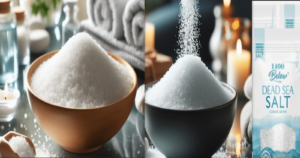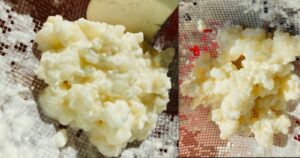Himalayan salt is a type of rock salt (halite) Pink in color that is primarily harvested from the Khewra Salt Mine in the Punjab region of Pakistan, near the foothills of the Himalayas.
Celtic salt, also known as Sel Gris (French for “grey salt”), is a type of sea salt that is harvested from the coastal region of Brittany, France, particularly the Guérande area. It is known for its grayish color, which comes from the minerals and clay found in the salt beds where it is harvested.

| Himalayan Salt | Celtic Salt |
|---|---|
| Origin: Mined from ancient sea beds in Pakistan | Origin: Harvested from coastal regions of Brittany, France |
| Color: Pink to reddish due to iron oxide | Color: Gray due to minerals and clay |
| Texture: Typically dry and coarse | Texture: Usually moist and coarse |
| Mineral Content: Rich in over 80 minerals, including iron, calcium, and magnesium | Mineral Content: Rich in minerals like magnesium, calcium, potassium, and trace elements |
| Taste: Mild, slightly sweet taste | Taste: Briny taste |
| Common Uses: Cooking, finishing salt, salt lamps, bath salts | Common Uses: Cooking, finishing salt, therapeutic baths |
| Health Benefits: Provides essential minerals, supports respiratory health, detoxifying properties | Health Benefits: Balances electrolytes, aids digestion, provides essential minerals |
| Harvesting Process: Mined from underground salt mines | Harvesting Process: Harvested from seawater in shallow ponds |
| Moisture Content: Typically low | Moisture Content: High moisture content |
| Crystal Size: Available in various sizes, including fine and coarse | Crystal Size: Generally coarse |
Health benefits of Himalayan salt vs Celtic salt
Health Benefits of Himalayan Salt
1. Mineral-Rich Composition:
- Contains over 80 trace minerals, including potassium, magnesium, and calcium, which are essential for various bodily functions.
- These minerals can help replenish electrolytes, support metabolic processes, and promote overall health.
2. Electrolyte Balance:
- Helps maintain electrolyte balance in the body, which is crucial for muscle function, hydration, and nerve signaling.
3. Detoxification:
- When used in baths, Himalayan salt is believed to help detoxify the skin and body by drawing out toxins and impurities.
- The minerals in the salt can also promote skin health and soothe sore muscles.
4. Respiratory Health:
- Salt inhalers using Himalayan salt are popular for improving respiratory health.
- Inhalation of salt particles can help clear mucus, reduce inflammation, and improve symptoms of respiratory conditions like asthma and allergies.
5. Hydration:
- Helps maintain proper hydration levels due to its balance of electrolytes, which can be beneficial for athletes and those with high physical activity levels.
6. Improved Digestion:


- Can aid in digestion by stimulating the production of digestive enzymes.
- Helps balance stomach acid levels and improve nutrient absorption.
7. Bone Health:
- The trace minerals in Himalayan salt, such as calcium and magnesium, are essential for maintaining healthy bones and preventing bone-related conditions.
8. Regulates Blood Sugar:
- Helps regulate blood sugar levels and may improve insulin sensitivity, which can be beneficial for individuals with diabetes or at risk of diabetes.
9. pH Balance:
- Promotes an optimal pH balance in the body by reducing acidity and creating an alkaline environment, which can improve overall health and reduce the risk of chronic diseases.
10. Better Sleep:
- The minerals in Himalayan salt can help promote relaxation and improve sleep quality by regulating the body’s natural sleep-wake cycle.
Health Benefits of Celtic Salt
1. Mineral-Rich Composition:
- Contains a broad spectrum of essential minerals and trace elements, including magnesium, calcium, potassium, and manganese.
- These minerals are crucial for maintaining various bodily functions and overall health.
2. Electrolyte Balance:
- Helps maintain electrolyte balance in the body, which is essential for muscle function, hydration, and nerve signaling.
- This can be particularly beneficial for athletes and individuals with high physical activity levels.
3. Improved Digestion:
- Can stimulate the production of digestive enzymes, aiding in digestion and improving nutrient absorption.
- May help balance stomach acid levels, promoting better digestive health.
4. Hydration:
- Helps maintain proper hydration levels due to its balance of electrolytes.
- The minerals in Celtic salt can aid in retaining water in the body, preventing dehydration.
5. Alkalizing Properties:
- Believed to help balance the body’s pH levels by reducing acidity and creating a more alkaline environment.
- An optimal pH balance can improve overall health and reduce the risk of chronic diseases.
6. Enhanced Immune Function:
- The trace minerals in Celtic salt, such as zinc and selenium, can support a healthy immune system.
- These minerals play a role in various immune functions, including the production of white blood cells.
7. Respiratory Health:
- Salt inhalation therapy using Celtic salt can help clear mucus, reduce inflammation, and improve symptoms of respiratory conditions like asthma and allergies.
8. Bone Health:
- The calcium and magnesium content in Celtic salt can help maintain healthy bones and prevent bone-related conditions.
9. Skin Health:
- When used in baths, Celtic salt can help detoxify the skin, draw out toxins, and improve skin texture and health.
- The minerals in the salt can soothe and repair the skin, making it beneficial for skin conditions like eczema and psoriasis.
10. Stress Reduction:
- The magnesium in Celtic salt can promote relaxation and reduce stress.
- Bathing in Celtic salt can provide a calming effect, improving sleep quality and reducing tension.
Both Himalayan and Celtic salts are marketed for their unique mineral content and health benefits. However, scientific evidence supporting these claims is limited. While these salts can be part of a healthy diet, they should not be relied upon for significant health improvements over regular table salt. It’s essential to focus on a balanced diet and overall healthy lifestyle to achieve the purported benefits associated with these salts.
Taste and Flavor of Himalayan salt and celtic salt
Himalayan Salt:

- Flavor Profile: Himalayan salt is known for its subtle and mild flavor with a hint of sweetness. It is less salty compared to regular table salt, making it a versatile seasoning that doesn’t overpower dishes.
- Texture: It comes in various textures, from fine grains to larger crystals, providing a pleasant crunch when used as a finishing salt.
- Color: The pink hue of Himalayan salt comes from trace minerals such as iron, magnesium, and calcium, which also contribute to its unique flavor profile.
Celtic Salt:
- Flavor Profile: Celtic salt has a briny, oceanic taste with a slightly stronger mineral flavor. It is moist and has a more complex taste due to its high mineral content, including magnesium, calcium, and potassium.
- Texture: Known for its moist, coarse grains, Celtic salt adds a crunchy texture when used as a finishing salt.
- Color: Typically grayish in color, this salt gets its hue from the clay lining of the salt beds where it is harvested.
Advantages & Disadvantages of Himalayan salt vs Celtic salt
| Himalayan Salt | Celtic Salt |
|---|---|
| Contains over 80 trace minerals, including potassium, magnesium, and calcium. | Rich in minerals like magnesium, iron, and zinc. |
| Not specifically noted for balanced profile. | Some believe the balance of minerals is beneficial for health. |
| Often less refined and processed, with no additives or anti-caking agents. | Harvested using traditional methods, usually from coastal regions. |
| Mined from ancient sea beds, free from many modern-day pollutants. | Often retains moisture and natural minerals due to minimal processing. |
| The variety of minerals may help maintain electrolyte balance. | The high mineral content may help maintain electrolyte balance. |
| Believed to aid in better hydration due to its mineral content. | Some people find it easier on the digestive system compared to table salt. |
| Using salt lamps or inhaling salt particles may improve respiratory health. | |
| Provides a unique flavor and the pink color adds visual appeal to dishes. | Offers a robust, briny flavor that enhances various dishes. |
Advantages of Himalayan Salt
- Mineral Content:
- Rich in Trace Minerals: Contains over 80 trace minerals, including potassium, magnesium, and calcium.
- Lower Sodium Content: Slightly lower sodium levels compared to regular table salt.
- Purity:
- Less Processed: Often less refined and processed, with no additives or anti-caking agents.
- Natural Harvesting: Mined from ancient sea beds, free from many modern-day pollutants.
- Aesthetic and Culinary Uses:
- Flavor and Appearance: Provides a unique flavor and the pink color adds visual appeal to dishes.
Advantages of Celtic Salt
- Mineral Content:
- High in Trace Minerals: Rich in minerals like magnesium, iron, and zinc.
- Balanced Mineral Profile: Some believe the balance of minerals is beneficial for health.
- Purity:
- Natural and Unprocessed: Harvested using traditional methods, usually from coastal regions.
- Moisture Content: Often retains moisture and natural minerals due to minimal processing.
- Health Benefits:
- Electrolyte Balance: The high mineral content may help maintain electrolyte balance.
- Digestive Health: Some people find it easier on the digestive system compared to table salt.
- Culinary Uses:
- Distinct Flavor: Offers a robust, briny flavor that enhances various dishes.

Disadvantages of Himalayan salt versus Celtic salt
| Himalayan Salt | Celtic Salt |
|---|---|
| Generally more expensive due to its harvesting and marketing. | Can be more expensive due to traditional harvesting methods. |
| Many health claims lack strong scientific support. | Health benefits are often anecdotal and lack robust scientific validation. |
| Trace minerals present are in very small amounts, unlikely to have significant health benefits. | While rich in minerals, the amounts are small and might not have significant health impacts. |
| Still high in sodium, which can contribute to high blood pressure and cardiovascular issues if consumed in excess. | Still high in sodium, and excessive intake can lead to similar health issues as other salts. |
| Potential environmental concerns if mining is unsustainable. | Less common, but traditional methods may still have environmental impacts. |
| Not typically an issue. | The moisture content can cause clumping and make it less convenient for certain uses. |
| Does not contain added iodine, which is essential for thyroid function. | Does not contain added iodine, potentially leading to iodine deficiency if not supplemented from other dietary sources. |
Disadvantage of Himalayan salt
- Cost:
- Expensive: Generally more costly due to its harvesting and marketing.
- Health Claims:
- Lack of Scientific Evidence: Many health claims lack strong scientific support.
- Minimal Impact: The trace minerals present are in very small amounts, unlikely to have significant health benefits.
- Sodium Content:
- Still High in Sodium: Can contribute to high blood pressure and cardiovascular issues if consumed in excess.
- Environmental Impact:
- Mining Practices: Potential environmental concerns if mining is unsustainable.
Disadvantages of Celtic Salt
- Cost:
- Expensive: Can be more expensive than regular table salt due to traditional harvesting methods.
- Health Claims:
- Lack of Scientific Evidence: Health benefits are often anecdotal and lack robust scientific validation.
- Minimal Impact: While rich in minerals, the amounts are small and might not have significant health impacts.
- Sodium Content:
- Still High in Sodium: Excessive intake can lead to similar health issues as other salts.
- Moisture Content:
- Storage Issues: The moisture content can cause clumping and make it less convenient for certain uses.
Key Comparason of Himalayan salt vs Celtic salt
- Mineral Content: Both salts are rich in trace minerals, but Celtic salt is often considered to have a better-balanced mineral profile.
- Purity: Both are less processed than regular table salt, but Celtic salt retains more moisture and minerals due to its harvesting method.
- Cost: Both are more expensive than regular table salt, with Himalayan salt often being marketed more aggressively.
- Health Benefits: Both have health claims that are not strongly supported by scientific evidence, and the actual health impact of the trace minerals is minimal.
- Culinary Uses: Both salts provide unique flavors and aesthetic appeal to dishes, with Celtic salt having a more robust flavor and Himalayan salt a more subtle one.
Nutritional Content and Comparison of Himalayan Salt, Celtic Salt, and Table Salt
| Himalayan Salt Mineral | Amount per tablespoon (mg) |
|---|---|
| Sodium | 14550.0000 |
| Potassium | 42.0000 |
| Calcium | 24.0000 |
| Magnesium | 15.0000 |
| Iron | 5.5400 |
| Manganese | 4.0500 |
| Phosphorus | 0.4200 |
| Zinc | 0.2400 |
| Copper | 0.0900 |
| Chromium | 0.0300 |
| Iodine | 0.0018 |
Here’s a comparison between Himalayan salt and regular table salt:
Himalayan Salt:
- Sodium: 14550 mg per tablespoon
- Potassium: 42 mg per tablespoon
- Calcium: 24 mg per tablespoon
- Magnesium: 15 mg per tablespoon
- Iron: 5.54 mg per tablespoon
- Manganese: 4.05 mg per tablespoon
- Phosphorus: 0.42 mg per tablespoon
- Zinc: 0.24 mg per tablespoon
- Copper: 0.09 mg per tablespoon
- Chromium: 0.03 mg per tablespoon
- Iodine: 0.0018 mg per tablespoon
Table Salt (fortified with iodine):
- Sodium: 17,330 mg per tablespoon
- Potassium: 1 mg per tablespoon
- Calcium: 0 mg per tablespoon
- Magnesium: 0 mg per tablespoon
- Iron: 0 mg per tablespoon
- Manganese: 0 mg per tablespoon
- Phosphorus: 0 mg per tablespoon
- Zinc: 0 mg per tablespoon
- Copper: 0 mg per tablespoon
- Chromium: 0 mg per tablespoon
- Iodine: 0.19 mg per tablespoon
Key Differences between Himalayan salt and Table salt
- Sodium Content:
- Himalayan Salt: Slightly lower sodium content than table salt.
- Table Salt: Higher sodium content.
- Mineral Content:
- Himalayan Salt: Contains trace amounts of various minerals such as potassium, calcium, magnesium, iron, manganese, zinc, and others.
- Table Salt: Lacks these trace minerals and is primarily composed of sodium chloride.
- Iodine Content:
- Himalayan Salt: Contains only trace amounts of iodine.
- Table Salt: Often fortified with iodine to prevent iodine deficiency.
- Processing:
- Himalayan Salt: Generally less processed, may contain natural impurities that give it a pink color.
- Table Salt: Highly processed to remove impurities and often contains additives like anti-caking agents.

Nutritional content of Celtic salt per tablespoon
| Celtic salt Mineral | Amount per tablespoon (mg) |
|---|---|
| Sodium | 6720.0000 |
| Potassium | 108.0000 |
| Calcium | 12.0000 |
| Magnesium | 8.0000 |
| Iron | 1.5000 |
| Manganese | 0.3500 |
| Phosphorus | 0.2500 |
| Zinc | 0.3000 |
| Copper | 0.1000 |
| Chromium | 0.0050 |
| Iodine | 0.0020 |
Nutritional Content Comparison between Himalayan salt and celtic salt
| Celtic Salt (mg) | Himalayan Salt (mg) |
|---|---|
| Sodium- 6720.0000 | Sodium-14550.0000 |
| Potassium-108.0000 | Potassium-42.0000 |
| Calcium-12.0000 | Calcium-24.0000 |
| Magnesium-8.0000 | Magnesium-15.0000 |
| Iron-1.5000 | Iron-5.5400 |
| Manganese-0.3500 | Manganese-4.0500 |
| Phosphorus-0.2500 | Phosphorus-0.4200 |
| Zinc-0.3000 | Zinc-0.2400 |
| Copper-0.1000 | Copper-0.0900 |
| Chromium-0.0050 | Chromium-0.0300 |
| Iodine-0.0020 | Iodine-0.0018 |
Key Differences:
- Sodium Content:
- Celtic Salt: Lower sodium content compared to Himalayan salt.
- Himalayan Salt: Higher sodium content.
- Potassium:
- Celtic Salt: Higher potassium content.
- Himalayan Salt: Lower potassium content.
- Calcium:
- Celtic Salt: Lower calcium content.
- Himalayan Salt: Higher calcium content.
- Magnesium:
- Celtic Salt: Lower magnesium content.
- Himalayan Salt: Higher magnesium content.
- Iron:
- Celtic Salt: Lower iron content.
- Himalayan Salt: Higher iron content.
- Manganese:
- Celtic Salt: Lower manganese content.
- Himalayan Salt: Higher manganese content.
- Phosphorus:
- Celtic Salt: Slightly lower phosphorus content.
- Himalayan Salt: Slightly higher phosphorus content.
- Zinc:
- Celtic Salt: Slightly higher zinc content.
- Himalayan Salt: Slightly lower zinc content.
- Copper:
- Celtic Salt: Slightly higher copper content.
- Himalayan Salt: Slightly lower copper content.
- Chromium:
- Celtic Salt: Lower chromium content.
- Himalayan Salt: Higher chromium content.
- Iodine:
- Celtic Salt: Slightly higher iodine content.
- Himalayan Salt: Slightly lower iodine content.
Both salts provide various minerals, but Himalayan salt generally has higher amounts of most minerals compared to Celtic salt, except for potassium, zinc, and copper. The choice between the two often depends on personal preference and specific dietary needs.
Who should avoid Himalayan Salt & Celtic salt
While Himalayan salt is generally considered safe for most people when used in moderation, certain individuals should be cautious or avoid using it:
Who should avoid Himalayan salt
People with High Blood Pressure:
- Reason: Himalayan salt, like regular table salt, contains a high amount of sodium, which can contribute to increased blood pressure.
- Advice: Individuals with hypertension should monitor their sodium intake and consult with their healthcare provider before making dietary changes.
People with Kidney Disease:
- Reason: High sodium intake can exacerbate kidney problems and lead to fluid retention.
- Advice: Those with kidney issues should avoid excessive salt intake and follow dietary recommendations from their healthcare provider.
People on Low-Sodium Diets:
- Reason: Some medical conditions require a low-sodium diet, and Himalayan salt contains significant sodium.
- Advice: Follow medical advice and dietary restrictions carefully.
People with Heart Disease:
- Reason: High sodium intake is linked to an increased risk of heart disease.
- Advice: Limit salt consumption and consult a healthcare provider for personalized dietary guidelines.
Pregnant Women:
- Reason: Excessive salt intake during pregnancy can lead to complications such as high blood pressure and fluid retention.
- Advice: Pregnant women should consume salt in moderation and consult their healthcare provider for dietary recommendations.
People with Certain Medications:
- Reason: Some medications may interact with high sodium levels.
- Advice: Check with a healthcare provider or pharmacist if taking medications that may be affected by salt intake.
Individuals Prone to Edema:
- Reason: High sodium intake can cause the body to retain water, leading to swelling (edema).
- Advice: Monitor salt intake and consult with a healthcare provider if prone to edema.
General Advice:
Even if you do not fall into these categories, it’s essential to consume Himalayan salt in moderation. The World Health Organization recommends that adults consume less than 5 grams (about one teaspoon) of salt per day to reduce the risk of heart disease and stroke. Always consult with a healthcare provider if you have concerns about your salt intake or health conditions that might be affected by dietary changes.
Who should avoid celtic salt
Here are some groups who should consider avoiding or limiting their intake of Celtic salt:
- Individuals with Hypertension (High Blood Pressure): High sodium intake can exacerbate high blood pressure, leading to an increased risk of heart disease and stroke.
- People with Kidney Disease: High sodium levels can put additional strain on the kidneys, potentially worsening kidney function.
- Individuals with Heart Disease: Excessive sodium intake can contribute to fluid retention and increased blood pressure, which can be harmful for those with heart conditions.
- Those with Edema (Swelling): Sodium can cause the body to retain water, which can worsen swelling and fluid retention in individuals with edema.
- People on a Low-Sodium Diet: For medical reasons, some individuals may be advised to follow a low-sodium diet. In such cases, even natural salts like Celtic salt should be consumed in moderation.
- Children: High sodium intake is generally not recommended for children, as it can impact their developing bodies and increase the risk of health issues later in life.
While Celtic salt is often considered a more natural and mineral-rich alternative to table salt, it still contains sodium and should be used with caution by those who need to monitor their sodium intake. Always consult with a healthcare professional if you have concerns about your salt consumption.

Origins and Sources of Himalayan and Celtic Salt
Himalayan Salt:
- Origin: Mined from ancient salt deposits in the Punjab region of Pakistan.
- Description: This salt is believed to have formed millions of years ago from the evaporation of ancient bodies of water. It is often pink in color due to trace minerals, including iron, magnesium, and calcium.
- Extraction: The salt is extracted from the Khewra Salt Mine, which is one of the largest and oldest salt mines in the world. The mining process involves traditional methods that ensure the purity and natural composition of the salt.
Celtic Salt:
- Origin: Harvested from the coastal areas of Brittany, France.
- Description: Also known as “Sel Gris” (grey salt), Celtic salt is harvested using ancient methods that involve channeling seawater into shallow ponds where it is left to evaporate naturally under the sun and wind. The grey color comes from the clay lining of the salt ponds, which imparts additional minerals.
- Extraction: This salt is hand-harvested using wooden tools to maintain its natural state. The process is labor-intensive and highly traditional, preserving the techniques passed down through generations. The salt is celebrated for its rich mineral content and moisture.
Both Himalayan and Celtic salts are valued for their unique mineral compositions and traditional harvesting methods, contributing to their popularity in culinary and health applications.
Processing and Purity of himalayan salt and celtic salt
Himalayan Salt
Extraction and Processing Methods
- Extraction:
- Himalayan salt is mined from the Khewra Salt Mine in Pakistan.
- The extraction process is largely traditional, using hand tools and minimal machinery to minimize environmental impact.
- Once extracted, the salt is transported for further processing.
- Processing:
- Washing: The raw salt is washed to remove impurities.
- Drying: The salt is then dried naturally or with the help of solar heat.
- Crushing: Dried salt is crushed into various sizes, from large chunks to fine grains.
- Packaging: The processed salt is packaged for commercial sale, ensuring it remains free from contaminants.
Degree of Refinement and Impact on Purity and Mineral Content
- Refinement Level: Himalayan salt is minimally refined. This means it retains most of its natural mineral content.
- Purity: Due to minimal processing, Himalayan salt retains its natural purity and has a high mineral content, including trace elements like calcium, magnesium, potassium, and iron, which give it a pink hue.
- Mineral Content: It is often marketed as a natural and unprocessed product, rich in various minerals and trace elements, which contribute to its health benefits and distinct taste.
Celtic Sea Salt
Extraction and Processing Methods
- Extraction:
- Celtic sea salt is harvested from the coastal regions of France, particularly in the Brittany region.
- The salt is collected using traditional methods, such as wooden rakes, to avoid contamination from metals.
- Seawater is channeled into shallow clay ponds and allowed to evaporate under the sun and wind, leaving behind the salt crystals.
- Processing:
- Hand-Harvesting: Salt is hand-harvested using wooden tools, ensuring the natural balance of minerals is preserved.
- Natural Drying: The harvested salt is dried naturally, either under the sun or in covered areas to protect it from rain.
- Minimal Handling: The salt undergoes minimal handling and processing to maintain its natural state.
Degree of Refinement and Impact on Purity and Mineral Content
- Refinement Level: Celtic sea salt is also minimally refined, similar to Himalayan salt. It undergoes very little processing, which helps retain its natural properties.
- Purity: The hand-harvesting and natural drying methods ensure that Celtic sea salt remains free from additives and chemicals, maintaining high purity.
- Mineral Content: It contains a variety of trace minerals, including magnesium, potassium, and calcium, which contribute to its grayish color and moist texture. The high mineral content is beneficial for health and provides a distinct flavor profile.
Comparative Overview
- Extraction: Both salts use traditional methods to minimize environmental impact and maintain natural purity.
- Processing: Minimal processing for both, focusing on natural drying and minimal handling to preserve mineral content.
- Purity: High purity for both, with no additives or chemicals.
- Mineral Content: Both salts retain a rich array of minerals due to minimal refinement, though the specific mineral composition varies depending on the source.
Himalayan salt and Celtic sea salt are both valued for their natural extraction methods, minimal processing, high purity, and rich mineral content. Their unique characteristics make them popular choices for culinary and health applications.
Storage and Shelf Life of Himalayan Salt and Celtic Salt
Himalayan Salt
Storage:
- Environment: Store in a cool, dry place away from moisture and humidity to prevent clumping.
- Container: Use airtight containers, such as glass jars or plastic containers with secure lids, to protect from moisture and contaminants.
- Location: Keep away from direct sunlight to preserve its mineral content and natural color.
Shelf Life:
- Indefinite: Due to its mineral composition and lack of organic material, Himalayan salt does not spoil or go bad. If stored properly, it can last indefinitely.
- Quality Maintenance: Over time, if exposed to moisture, the salt may clump or harden. However, this does not affect its quality or safety for consumption. Simply break up the clumps if necessary.
Celtic Sea Salt
Storage:
- Environment: Similar to Himalayan salt, Celtic sea salt should be stored in a cool, dry place to prevent it from absorbing moisture from the air.
- Container: Airtight containers are recommended to maintain its quality. For Celtic salt, which is often moist, it may be beneficial to use breathable containers like ceramic jars that allow some airflow while still protecting from contaminants.
- Location: Store away from direct sunlight to maintain its natural color and mineral content.
Shelf Life:
- Indefinite: Celtic sea salt also has an indefinite shelf life due to its natural mineral content and lack of organic matter.
- Quality Maintenance: The salt may retain some moisture, which is normal and does not affect its shelf life. If it becomes too wet, it can be spread out to dry naturally. As with Himalayan salt, any clumping can be addressed by breaking up the clumps.
Both Himalayan salt and Celtic sea salt have an indefinite shelf life when stored properly. Key points for storage include keeping them in a cool, dry place, using airtight containers, and avoiding direct sunlight. Proper storage ensures these salts maintain their quality, mineral content, and safety for consumption over time.
Diverse Non-culinary Uses of Himalaya salt and Celtic salts
Himalayan Salt
Spa Treatments
- Himalayan Salt Baths:
- Detox Baths: Dissolving Himalayan salt in bathwater is believed to draw out toxins, promote relaxation, and improve skin hydration.
- Mineral Baths: The minerals in Himalayan salt can help soothe sore muscles, reduce inflammation, and enhance skin health.
- Salt Scrubs:
- Exfoliation: Finely ground Himalayan salt can be mixed with oils to create exfoliating scrubs that remove dead skin cells and leave the skin feeling soft and smooth.
- Salt Stones:
- Massage Therapy: Heated Himalayan salt stones are used in massages to provide deep muscle relaxation, improve circulation, and infuse the skin with beneficial minerals.
- Salt Inhalers:
- Respiratory Health: Inhalers filled with Himalayan salt are used to help alleviate respiratory issues, such as asthma, allergies, and colds by providing a form of halotherapy.
Decorative Purposes
- Salt Lamps:
- Ambient Lighting: Himalayan salt lamps emit a warm, pinkish glow, creating a calming and relaxing atmosphere in homes and offices.
- Air Purification: These lamps are believed to purify the air by releasing negative ions that attract pollutants, although scientific support for this is limited.
- Salt Candle Holders:
- Decorative Lighting: Himalayan salt candle holders provide a similar ambient lighting effect as salt lamps and are used for their aesthetic appeal and soothing light.
- Decorative Salt Blocks:
- Home Décor: Large blocks of Himalayan salt can be used as unique decorative pieces in homes, adding a natural and rustic touch to the décor.
Celtic Sea Salt
Spa Treatments
- Bath Soaks:
- Relaxation Baths: Celtic sea salt is added to bathwater to help relax muscles, soothe skin, and provide a mineral-rich soak.
- Therapeutic Baths: The trace minerals in Celtic sea salt can help detoxify the body, reduce inflammation, and promote overall skin health.

2. Salt Scrubs:
- Exfoliation: Coarse Celtic sea salt is used in body scrubs to exfoliate the skin, remove dead skin cells, and improve circulation.
3. Foot Soaks:
- Foot Baths: Adding Celtic sea salt to warm water for a foot soak can help soften calluses, reduce swelling, and relieve foot fatigue.
Decorative Purposes
- Decorative Jars:
- Layered Salt Jars: Different textures and colors of Celtic sea salt can be layered in glass jars for a decorative effect, often used in homes or as gifts.
- Craft Projects:
- Sand Art: Celtic sea salt can be used in craft projects such as sand art, where the salt is colored and layered to create intricate designs.
- Vase Fillers: Coarse Celtic sea salt can be used as a filler in decorative vases, adding a rustic and natural look to floral arrangements.
- Salt Crystals:
- Crystal Gardens: Celtic sea salt crystals can be used to create decorative crystal gardens, which are both a fun project and a unique decorative piece.
Therapeutic and Wellness
- Salt Therapy (Halotherapy):
- Salt Rooms: Rooms lined with Himalayan or Celtic salt, where people sit and breathe in the salty air to improve respiratory conditions and skin health.
- Salt Inhalers: Inhalers filled with salt crystals are used to provide relief for respiratory issues by simulating the effects of halotherapy.
These applications highlight the diverse uses of Himalayan and Celtic sea salts in enhancing wellness, relaxation, and home aesthetics beyond their culinary uses.
Historical and Cultural Significance: Himalayan and Celtic salt
Historical Uses and Cultural Importance
- Historical Uses: Himalayan salt, primarily sourced from the Khewra Salt Mine in Pakistan, has been used for centuries for both culinary and medicinal purposes. Historically, it was considered a valuable commodity and was often traded along ancient trade routes. In regions near the Himalayas, it was used in cooking, preserving food, and as a remedy for various ailments due to its mineral content.
- Cultural Importance: In many South Asian cultures, Himalayan salt holds a special place. It is believed to bring good health and is used in various traditional rituals and practices. In Ayurveda, it is valued for its supposed healing properties and is used in treatments to balance the body’s electrolytes and improve digestion.
Traditional Methods of Harvesting
- Harvesting: The traditional method of harvesting Himalayan salt involves mining from ancient sea beds that have been crystallized over millions of years. The Khewra Salt Mine, one of the oldest and largest in the world, uses both traditional and modern mining techniques. Historically, salt was extracted manually with simple tools, and workers would use traditional lamps to light the underground tunnels.
- Cultural Heritage: The Khewra Salt Mine itself is a cultural and historical landmark, attracting tourists who are interested in the ancient methods of salt extraction and the mine’s historical significance. The local communities have passed down the knowledge of salt mining through generations, preserving the traditional techniques and cultural heritage associated with it.
Celtic Salt
Historical Uses and Cultural Importance
- Historical Uses: Celtic salt, often referred to as “Sel gris” or “Gray salt,” is harvested from the coastal areas of France, particularly Brittany. Historically, it has been used in European cuisines for its distinctive flavor and mineral content. It was also used in various preservation methods for meat and fish.

- Cultural Importance: In Celtic regions, salt was a crucial part of the diet and a key trade item. It played a significant role in the local economy and was often used in barter. The harvesting and use of Celtic salt are deeply embedded in the cultural traditions of the coastal communities in Brittany, where salt production is considered both an art and a science.
Traditional Methods of Harvesting
- Harvesting: Celtic salt is traditionally harvested by hand using wooden tools in the Guérande region of France. The process involves allowing seawater to flow into shallow clay ponds where it is evaporated by the sun and wind. The remaining salt crystals are then carefully raked and collected. This artisanal method ensures that the salt retains its natural minerals and moisture.
- Cultural Heritage: The traditional methods of harvesting Celtic salt are considered an important cultural practice in Brittany. The salt workers, known as “paludiers,” have a deep respect for the environment and follow age-old techniques that have been passed down through generations. The Guérande salt marshes are a protected area, and the traditional harvesting methods are recognized for their ecological and cultural importance.
Comparison
- Historical Significance: Both Himalayan and Celtic salts have a rich historical significance, having been used for centuries in various cultures for culinary, medicinal, and preservation purposes.
- Cultural Importance: While Himalayan salt is deeply embedded in South Asian traditions and Ayurveda, Celtic salt holds a special place in the cultural heritage of the Brittany region in France.
- Traditional Harvesting Methods: Both types of salt are harvested using traditional methods that have been preserved through generations. Himalayan salt is mined from ancient sea beds, while Celtic salt is hand-harvested from coastal marshes using artisanal techniques.
These traditional practices not only ensure the quality and uniqueness of the salts but also preserve the cultural heritage and ecological balance of their respective regions.
10 common questions about Himalayan salt vs. Celtic salt with concise answers
What is Himalayan salt?
- Himalayan salt is a pink-colored rock salt mined from the Khewra Salt Mine in Pakistan.
What is Celtic salt?
- Celtic salt is a type of sea salt harvested from the coastal regions of France, known for its grayish color and moisture content.
Which has more minerals, Himalayan salt or Celtic salt?
- Both salts contain trace minerals, but Himalayan salt is often noted for having a slightly higher variety of minerals.
Is Himalayan salt better for cooking than Celtic salt?
- Himalayan salt is commonly used for cooking due to its larger, more uniform crystals that dissolve easily.
Can Celtic salt be used in cooking?
- Yes, Celtic salt can be used in cooking, but its moisture content makes it better suited for finishing dishes rather than high-heat cooking.
Which salt is better for health, Himalayan or Celtic?
- Both salts offer health benefits due to their mineral content, but there is no clear evidence that one is significantly better than the other.
Does Himalayan salt have a unique flavor?
- Himalayan salt has a mild flavor with a slight mineral taste, making it a versatile seasoning.
Does Celtic salt have a unique flavor?
- Celtic salt has a briny, oceanic flavor due to its mineral content and moisture, adding a distinctive taste to dishes.
Is there a difference in sodium content between Himalayan and Celtic salt?
- Both salts have similar sodium content, but the presence of other minerals can slightly affect their overall composition.
Are there any unique uses for Himalayan salt or Celtic salt?
- Himalayan salt can be used in salt lamps and spa treatments, while Celtic salt is often used in traditional recipes and for fermenting foods due to its mineral content and moisture.
Resources
https://en.wikipedia.org/wiki/Himalayan_salt
https://pubmed.ncbi.nlm.nih.gov/35137791
https://www.celticseasalt.com/blog/my-trip-to-the-salt-production-of-our-fossil-river-salts









